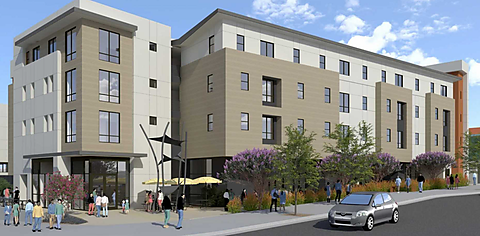Norbert Michel and Jerome Famularo
In the aftermath of the COVID-19 pandemic, the United States experienced a much higher rate of inflation than at any time during the prior few decades. Like the prices of many goods and services, the cost of housing rose rapidly, with the median home price increasing by almost $100,000. (Figure 1.) Unsurprisingly, many potential homebuyers were—and still are —shocked and upset.
As in years past, many politicians have latched on to the anger surrounding the recent housing market turmoil. During the presidential debate, Vice President Kamala Harris said, “Here’s the thing: we know that we have a shortage of homes and housing. And the cost of housing is too expensive for far too many people.” Before the election, Donald Trump outlined his solutions, and now federal officials want to implement a host of policies, ranging from subsidies to selling federal land.
But is the United States really facing a housing crisis? Or a shortage of homes? And should Americans expect recent federal policy proposals to make housing more affordable?
This Cato at Liberty post is the fifth in a series that examines these questions. (Previous posts are here, here, here, and here.) While the series presents evidence that the United States is not facing a true housing crisis or shortage, nothing in the series suggests that local officials should refrain from relaxing zoning restrictions and other regulations. Elected officials should reduce rules and regulations to make it easier and less costly for people to live. Additionally, federal officials should end the many demand-side policies that place upward pressure on prices nationwide.
Just as important, nothing in the series ignores that many Americans have taken an economic beating these past few years—real wages have fallen, and prices have not reverted to pre-COVID-19 levels. It is no surprise that so many people have been calling for increased government intervention.
As previously mentioned, though, if federal officials answer those calls, it will likely increase Americans’ economic burden. Evidence shows that over the long-term people have overcome the many federal roadblocks that increase the nominal cost of housing, but affordability would be much improved in the absence of those policies.
Fortunately, federal officials have an excellent opportunity to make it easier for Americans to afford housing because the lessons learned from the post-COVID-19 inflationary episode are directly applicable to the housing market. In both cases, federal policies that distort both demand and supply result in harmful outcomes. The housing market is just a microcosm of what can go wrong—and how difficult it can be to fix—when the federal government interferes with markets.
This post examines the origins of the so-called housing shortage figures and why these figures are not indicative of a true housing supply crisis.
In July 2017, a Politico story titled Why Washington Can’t Fix the New Housing Crisis stated:
The crisis is a shortage of houses. Nationally, the inventory of homes for sale has been shrinking for 24 straight months, stoking bidding wars for even the lowliest fixer-uppers. In January, a measure of supply hit its lowest in history, according to the National Association of Realtors.
The National Association of Realtors (NAR) is a trade group for people who earn a living selling homes. Although there is absolutely nothing wrong with the NAR or similar groups advocating for its members, it should not come as a surprise that the NAR would prefer a larger inventory of homes for sale. This measure is not, strictly speaking, a formal measure of supply.
This difference is more than just technical.
First, an optimally performing market would reduce friction between buyers and sellers, shrinking the time a house needs to be listed for sale. This performance minimizes the inventory of homes for sale, so a declining inventory could be a sign that the market is working better for buyers and sellers. Put differently, if the market is working well, the “normal” inventory level should decline. Given the increased use of technology in real estate markets during the last few decades, the lower inventory could indicate market improvements, where the time and effort to find and purchase a home have fallen.
Additionally, the inventory figure says little about the unique factors that drive the supply of housing construction. That is, the inventory available for sale says very little about the factors that contribute directly to the equilibrium supply of housing.
Again, this issue is more than just technical.
Because the inventory figure ignores equilibrium supply conditions, attempts to make up a “shortage” over current levels based on this metric (or similar ones) could further constrain basic supply factors (labor, materials, land, etc.) and drive prices even higher. As became obvious in the wake of the COVID-19 pandemic, these kinds of supply constraints can easily increase the price of a new home. Indeed, these factors can even outweigh the downward pressure that increased construction might place on prices, so much so that home price growth increases despite above-normal construction. Research has also shown that increased supply can ultimately increase prices by improving a neighborhood.
The kinds of metrics that various groups, such as the NAR, use to estimate the “shortage” do not account for these factors.
Running the Numbers
Many groups, including the NAR, argue that the tight inventory of homes for sale—including both newly constructed and previously occupied homes—is a key driver of a housing crisis. They also argue that the U.S. faces “an acute shortage of available housing” after “decades of underbuilding and underinvestment.”
For years, various groups have tried to quantify this so-called shortage, and the estimates vary considerably. For example, for 2024, Freddie Mac, one of the two large housing government-sponsored enterprises (GSEs), estimated a shortage of 3.7 million units. Separately, the National Association of Home Builders (NAHB) estimated a 2024 shortage of 1.5 million units.
In 2018, Freddie Mac estimated a shortage of 2.5 million units. The NAHB estimated a shortage of “about a million units” for 2019, while Up For Growth estimated the 2019 shortage to be 3.8 million units (a figure close to Freddie Mac’s 2020 shortage estimate of 3.8 million). In 2021, the NAHB estimated a shortage of 1.5 million units, while a study for the National Association of Realtors (NAR) estimated the shortage to be between 5.5 million and 6.8 million units. In 2022, the tech-based real estate firm Zillow estimated that “despite a pandemic construction boom, the US housing shortage grew to 4.5 million homes.”
These groups use somewhat different methodologies to produce their estimates, but none of them are designed to estimate an economic shortage. That is, they are typically referring to a market where supply is less than some preferred measure, not a market where the quantity demanded exceeds the quantity supplied at the market price. Put differently, the shortages estimated by the abovementioned groups do not, as the 2024 Economic Report of the President implies, represent market failures.
Again, this difference is more than just technical.
Such metrics, by design, do not refer to a situation where buyers (or renters) cannot buy (or rent) at a given market price. That is, these metrics do not answer the key question of whether housing construction tends to keep up with demand, ensuring that people generally can find a place to live.
There is no doubt that millions of people would prefer to pay less for housing. However, the fact that every person is unable to pay as little as they prefer for the housing that they want is not a market failure. In any market, for any given demand, the only way to ensure such an outcome would be to shift the supply curve so far to the right that the additional supply pushes the market price to effectively zero.
It is just as important to note that these metrics generally do not estimate the role of specific demand factors, such as income growth, interest rates, subsidies, or consumer preferences. Consumers might prefer to live in certain locations, or in certain kinds of homes, with various amenities, but these factors are not measured in these “shortage” metrics. This omission alone is critical because these demand factors could result in higher home price growth even in the face of heightened construction.
Our point here is not that these measures are objectively wrong, and we are not criticizing the models themselves. Nor are we ignoring that some people would be better off if housing costs were lower.
We are, however, pointing out that these models typically do not provide formal estimates of the optimal housing demand and supply in an equilibrium framework. Broadly, these groups have constructed reasonable statistical models to suggest what the supply of new homes should be based on their preferred criteria. However these estimates do not represent an economic shortage, a situation where consumers are willing to pay for a product at the prevailing price but are still unable to find a unit to purchase.
Often, shortages are the result of price ceilings imposed by the government, such as rent control or price caps. Obviously, if the federal government mandated enough increased housing supply to hold housing prices (or rents) below some arbitrarily “affordable” price, many of the same critiques that apply to more straightforward price ceiling policies would apply.
To be sure, we make no judgment about which prices are “affordable” enough to end the kind of “shortage” these metrics estimate. We are merely pointing out that it is very risky to equate these figures to an economic crisis or a market failure that requires government intervention (especially on a nationwide basis).
Enacting expansionary policies based on these “shortage” figures could make housing market conditions worse than today. These kinds of federal policies could, for example, boost demand beyond optimal levels, putting upward pressure on prices by flooding the market with buyers. Alternatively, they could boost supply beyond optimal levels, putting upward pressure on prices by straining resources in the construction industry.
Breaking Down the Models
To demonstrate what these “shortage” models estimate, this post provides a brief overview of the underlying methodologies used by several groups. (This Brookings article by David Wessel also provides a good overview of the various methods.)
While the methods vary, most assume that some kind of buffer stock (or inventory) of homes is needed. Freddie Mac’s model, for instance, includes the existing vacancy rate (the share of homeowner inventory that is vacant/for sale), and a target vacancy rate. It also includes, among other variables, a target household formation rate.
Freddie Mac’s model sets its target vacancy rate at 13 percent to “ensure that there is a well-functioning housing market, which requires some vacant properties for sale and for rent.” While Freddie Mac is free to set the model’s target vacancy rate at any value it prefers, as Figure 12 shows, the total vacancy rate was below 13 percent from the mid-1960s to the mid-2000s, and again from the mid-2010s until the present. The only time the vacancy rate was at or above 13 percent was during the period leading up to and following the housing crisis and subsequent Great Recession. Given the connection between federal housing policy and this recession, it seems odd to target a vacancy rate from this period.
Separately, the target household figure is based on 5‑year population groups and the target “headship” rate for those groups. (The headship rate is the number of heads of households as a percentage of total households.) Freddie Mac also adjusts the headship rate for factors such as “housing costs, income, and employment,” factors that can affect both household formation and the decision to buy a home.
Thus, while Freddie Mac’s model does not, strictly speaking, measure the demand for housing, it demonstrates how difficult it is to measure housing demand because many of the variables that affect household formation and housing costs are determined simultaneously. If, for example, housing costs are low and income growth is strong, young adults will be more likely to move out of their parents’ homes and form their own households. Yet, at the same time, if young adults are more likely to move and form their own households, their behavior can affect housing costs and opportunities to earn income.
Setting these statistical problems aside, Freddie Mac’s model estimates how close construction gets to a benchmark based partly on household formation targets. We make no judgment as to what household formation rates should be, and we argue that the federal government should not intervene in housing markets based on anyone’s preferred household formation rates.
People can, for instance, move in and out of their parents’ homes, and parents can move in and out of their children’s homes, for a variety of reasons, including health or economic conditions. Federal housing policy should not “push” people to speed up or slow down the rate at which they form new households.
The group Up For Growth uses a similar approach to Freddie Mac, but its model includes a target vacancy rate of 5 percent. Additionally, instead of using target households, it uses missing households, a variable that estimates the number of people who, although they are currently living with families or non-relatives, would like to live on their own. (Zillow also uses missing holds.)
Separately, the NAHB relies on a more parsimonious comparison of the difference between the current vacancy rate and “the ‘natural,’ or long-run average” vacancy rate, while the NAR’s study relies on a comparison of the long-term construction trend to current construction. (The NAR study also provides an alternate shortage estimate of 6.8 million units based on the following calculation: Household Formation + Lost Housing Stock – New Completions.) Separately, the NAR’s online “Housing Shortage Tracker” estimates the shortage for major U.S. metro areas by comparing the number of new construction permits issued to “every new job.”
Apart from these groups, a 2022 academic paper by economists Kevin Corinth and Hugo Dante estimates that the United States had a housing shortage of 20.1 million homes in 2021. This figure may seem like an obvious outlier among the various shortage estimates discussed so far, but the methodological approach is also somewhat unique.
Unlike the other measures discussed in this post, Dante and Corinth estimate the quantity of housing that would exist in the absence of certain supply constraints, such as zoning and regulatory restrictions. Thus, their end goal is very different from the groups so far discussed. Interestingly, Dante and Corinth state, “Of course, economists do not typically use the term housing shortage to express the quantity-reducing effects of supply constraints—while prices may be artificially elevated, any buyer can generally purchase a home at the market price. We nonetheless follow popular discourse and abuse economic terminology.”
Terminology abuse aside, their model relies on a concept called land share, the portion of a home’s price that represents the land the home is built on. Using this concept, they report that 20.1 million additional homes would have been built in the absence of zoning and other regulatory constraints. Their key assumption, based on other academic research, is that the land share will fall to “about 20 percent of the value of a home” in a market without supply constraints. As Figure 3 shows, recent estimates for US land share vary considerably, but it appears that the land share was higher than 20 percent from 1931 to 1946, lower than 20 percent until 1971, and consistently higher after 1971.
The authors then rely on estimates (based on other academic research) of the price elasticity of demand for housing to calculate “the equilibrium quantity of housing in each market absent supply constraints.” The authors acknowledge that the metro areas with the least stringent regulations tend to have land shares clustered around 20 percent, and then assume that relaxing regulations would cause the land share in more strictly regulated areas to move toward 20 percent.
Using 2023 land share estimates provided by the American Enterprise Institute, the typical (median) US home price would have to fall 44 percent to reduce the land share to 20 percent. The price decline would be steeper in higher-cost areas. In San Francisco, for example, the price would have to decline almost 60 percent, from $1.4 million to less than $600,000.
We do not dispute that more housing would be built in the absence of strict zoning or regulatory restrictions, and we have consistently argued in these posts that state and local governments should reduce regulations to make it less costly for people to build the homes they want to live in. Nothing in this series implies that more construction cannot be beneficial.
However, federal housing policy should not be geared toward achieving a land share of 20 percent—or any other land share figure—for the nation’s housing markets. The results could be disastrous, much like when President Clinton’s National Partners in Homeownership, a private-public cooperative, set a goal of raising the US homeownership rate from 64 percent to 70 percent by 2000.
To whatever extent they cause lower land shares, it is doubtful that less stringent regulations are the sole cause of low land values or that high regulations are the sole cause of higher land values. The optimal share in certain areas could be higher than 20 percent because land is scarcer, and those areas are in higher demand. And additional construction could cause demand to go even higher.
As we’ve argued in this series, local housing markets experience their own unique dynamics, and there are surely many rules and regulations that could be relaxed to improve local problems. But those decisions are best left to state and local officials who live in those communities, especially because it is so difficult to objectively define a shortage or a surplus. The federal government should not be in the business of deciding the type and number of homes that people can build in their communities.
The next post in this series will be released after New Year’s Day.
























